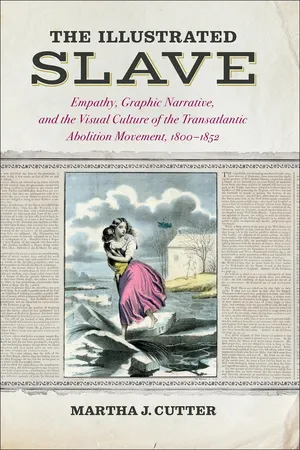
The Illustrated Slave
Empathy, Graphic Narrative, and the Visual Culture of the Transatlantic Abolition Movement, 1800–1852
- 312 pages
- English
- ePUB (mobile friendly)
- Available on iOS & Android
The Illustrated Slave
Empathy, Graphic Narrative, and the Visual Culture of the Transatlantic Abolition Movement, 1800–1852
About This Book
From the 1787 Wedgwood antislavery medallion featuring the image of an enchained and pleading black body to Quentin Tarantino's Django Unchained (2012) and Steve McQueen's Twelve Years a Slave (2013), slavery as a system of torture and bondage has fascinated the optical imagination of the transatlantic world. Scholars have examined various aspects of the visual culture that was slavery, including its painting, sculpture, pamphlet campaigns, and artwork. Yet an important piece of this visual culture has gone unexamined: the popular and frequently reprinted antislavery illustrated books published prior to Harriet Beecher Stowe's Uncle Tom's Cabin (1852) that were utilized extensively by the antislavery movement in the first half of the nineteenth century.
The Illustrated Slave analyzes some of the more innovative works in the archive of antislavery illustrated books published from 1800 to 1852 alongside other visual materials that depict enslavement. Martha J. Cutter argues that some illustrated narratives attempt to shift a viewing reader away from pity and spectatorship into a mode of empathy and interrelationship with the enslaved. She also contends that some illustrated books characterize the enslaved as obtaining a degree of control over narrative and lived experiences, even if these figurations entail a sense that the story of slavery is beyond representation itself. Through exploration of famous works such as Uncle Tom's Cabin, as well as unfamiliar ones by Amelia Opie, Henry Bibb, and Henry Box Brown, she delineates a mode of radical empathy that attempts to destroy divisions between the enslaved individual and the free white subject and between the viewer and the viewed.
Frequently asked questions
Information
Table of contents
- Cover
- Title Page
- Copyright Page
- Contents
- Acknowledgments
- Preface
- Introduction: Visualizing Slavery and Slave Torture
- Chapter One: Precursors: Picturing the Story of Slavery in Broadsides, Pamphlets, and Early Illustrated Graphic Works about Slavery, 1793–1812
- Chapter Two: “These Loathsome Pictures Shall Be Published”: Reconfigurations of the Optical Regime of Transatlantic Slavery in Amelia Opie’s The Black Man’s Lament (1826) and George Bourne’s Picture of Slavery in the United States of America (1834)
- Chapter Three: Entering and Exiting the Sensorium of Slave Torture: A Narrative of the Adventures and Escape of Moses Roper, from American Slavery (1837, 1838) and the Visual Culture of the Slave’s Body in the Transatlantic Abolition Movement
- Chapter Four: Structuring a New Abolitionist Reading of Masculinity and Femininity: The Graphic Narrative Systems of Lydia Maria Child’s Joanna (1838) and Henry Bibb’s Narrative of the Life and Adventures of Henry Bibb, an American Slave, Written by Himself (1849)
- Chapter Five: After Tom: Illustrated Books, Panoramas, and the Staging of the African American Enslaved Body in Uncle Tom’s Cabin (1852) and the Performance Work of Henry Box Brown (1849–1875)
- Epilogue: The End of Empathy, or Slavery Revisited via Twentieth- and Twenty-First-Century Artworks
- Appendix: Hierarchical and Parallel Empathy
- Notes
- Bibliography
- Index